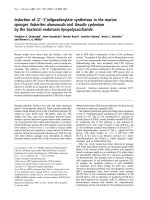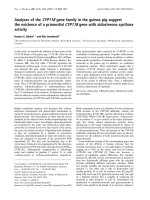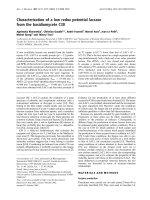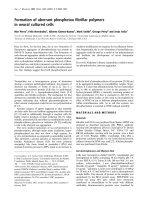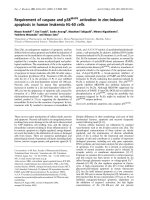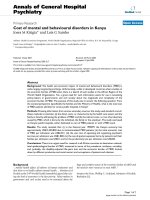Báo cáo y học: "Incidence of early posterior shoulder dislocation in brachial plexus birth palsy" pptx
Bạn đang xem bản rút gọn của tài liệu. Xem và tải ngay bản đầy đủ của tài liệu tại đây (270.57 KB, 5 trang )
BioMed Central
Page 1 of 5
(page number not for citation purposes)
Journal of Brachial Plexus and
Peripheral Nerve Injury
Open Access
Research article
Incidence of early posterior shoulder dislocation in brachial plexus
birth palsy
Lars B Dahlin*
1
, Kristina Erichs
2
, Charlotte Andersson
1
,
Catharina Thornqvist
1
, Clas Backman
3
, Henrik Düppe
4
, Pelle Lindqvist
5
and
Marianne Forslund
2
Address:
1
Department of Hand Surgery, Malmö University Hospital, Malmö, Sweden,
2
Child and Habilitation Unit, Malmö University Hospital,
Malmö, Sweden,
3
Department of Hand Surgery, Norrland University Hospital, Umeå, Sweden,
4
Department of Orthopaedic Surgery, Malmö
University Hospital, Malmö, Sweden and
5
Department of Paediatrics/Urology/Gynecology/Endocrinology, Malmö University Hospital, Malmö,
Sweden
Email: Lars B Dahlin* - ; Kristina Erichs - ;
Charlotte Andersson - ; Catharina Thornqvist - ;
Clas Backman - ; Henrik Düppe - ; Pelle Lindqvist - ;
Marianne Forslund -
* Corresponding author
Abstract
Background: Posterior dislocation of the shoulder in brachial plexus birth palsy during the first
year of life is rare but the incidence increases with age. The aim was to calculate the incidence of
these lesions in children below one year of age.
Methods: The incidence of brachial plexus birth lesion and occurrence of posterior shoulder
dislocation was calculated based on a prospective follow up of all brachial plexus patients at an age
below one in Malmö municipality, Sweden, 2000–2005.
Results: The incidence of brachial plexus birth palsy was 3.8/1000 living infants and year with a
corresponding incidence of posterior shoulder dislocation (history, clinical examination and x-ray)
during the first year of 0.28/1000 living infants and year, i.e. 7.3% of all brachial plexus birth palsies.
Conclusion: All children with a brachial plexus birth lesion (incidence 3.8‰) should be screened,
above the assessment of neurological recovery, during the first year of life for posterior dislocation
of the shoulder (incidence 0.28‰) since such a condition may occur in 7% of children with a
brachial plexus birth lesion.
Background
Brachial plexus birth lesions occur with an incidence of
around 2.3–3.3/1000 live births per year [1,2]. Spontane-
ous recovery is common but as many as 25% of teenagers
with a brachial plexus birth lesion may have secondary
complications, which are mostly located in the shoulder
region with the deformity, medial rotation contracture
and problems with activity of daily living (ADL; [3]). An
untreated medial rotation contracture may lead to poste-
rior subluxation or dislocation since the natural history of
Published: 16 December 2007
Journal of Brachial Plexus and Peripheral Nerve Injury 2007, 2:24 doi:10.1186/1749-7221-2-
24
Received: 13 August 2007
Accepted: 16 December 2007
This article is available from: />© 2007 Dahlin et al; licensee BioMed Central Ltd.
This is an Open Access article distributed under the terms of the Creative Commons Attribution License ( />),
which permits unrestricted use, distribution, and reproduction in any medium, provided the original work is properly cited.
Journal of Brachial Plexus and Peripheral Nerve Injury 2007, 2:24 />Page 2 of 5
(page number not for citation purposes)
untreated brachial plexus birth palsy with residual weak-
ness is progressive glenohumeral deformity due to persist-
ent muscle imbalance. Progressive deformity has also
been found with increasing age [4]. Posterior shoulder
dislocation can occur even before the age of one, but the
etiology of such an early lesion, which include particularly
birth trauma, use of splint devices or muscle imbalance, is
still not clarified [5-9]. Recently, the frequency of the con-
dition was reported in consecutive cases with brachial
plexus birth palsy below the age of one [5,6]. As many as
8 (11/134) to 10% of the children may have a posterior
shoulder dislocation before their first birthday. However,
the incidence of posterior dislocation in relation to bra-
chial plexus birth palsy in children below one year of age
has not previously been reported. Our aim was to deter-
mine the incidence of posterior dislocation of the shoul-
der among children with an age below one and the
corresponding incidence of brachial plexus birth lesion in
Malmö municipality, Sweden, during 2000–2005.
Methods
All children born at Malmö University hospital and living
in Malmö municipality (mean population of Malmö 263
550 during the study period) with signs of brachial plexus
birth palsy are referred within days for follow-up to the
Unit of Child Habilitation. The children have been fol-
lowed by the same physiotherapist since 1982 (KE) and
by a child neurologist (MF). Similar treatment strategies
have been adopted during these years, i.e. prophylactic
exercises against contracture [regular oral and written
(schematic drawing with instruction of specific exercises
to prevent particularly shoulder contracture) instructions
to parents], regular follow-up of neurological recovery
and observation of any signs of development of medial
rotation contracture. The procedures have essentially not
changed during the time period. Since 1997 most chil-
dren, and since 2000 all children, with a brachial plexus
birth palsy have also been prospectively examined at reg-
ular intervals by a hand surgeon (LD) to judge recovery of
the neurological deficit of the brachial plexus lesion and
particularly any development of shoulder dysfunction
including development of contracture and signs of dislo-
cation. A study of persistent symptoms in teenagers with a
brachial plexus birth lesion has previously been published
from Malmö [3]. The diagnosis of posterior shoulder dis-
location was based on the history (sudden development
of impaired external rotation), a clinical examination
[impaired passive external rotation, asymmetry of the
shoulder with palpable humeral head posteriorly, short-
ening of the length of the upper arm and asymmetry of
skin fold due to telescoping of humerus and axillary asym-
metry], conventional x-ray (all cases) and MRI/CT (one
case).
Results
During 2000–2005 21610 living infants were born at
Malmö University hospital in Malmö, Sweden. Of these,
82 children had a brachial plexus birth palsy and the chil-
dren were referred to the Child Habilitation Unit for fol-
low up. The mean incidence of brachial plexus birth palsy
was 3.8/1000 living infants per year with a slight variation
during the six years (Figure 1). During 2000–2005, we
Incidence of brachial plexus birth palsy and early (age less than one year) posterior dislocation of the shoulder per 1000 living born infants and year 2000–2005 in Malmö municipality, SwedenFigure 1
Incidence of brachial plexus birth palsy and early (age less than one year) posterior dislocation of the shoulder per 1000 living
born infants and year 2000–2005 in Malmö municipality, Sweden. The numbers correspond to a frequency of 7.3% (six poste-
rior shoulder dislocations out of 82 brachial plexus birth palsies during 2000–2005).
Journal of Brachial Plexus and Peripheral Nerve Injury 2007, 2:24 />Page 3 of 5
(page number not for citation purposes)
observed one case per year with a posterior shoulder dis-
location occurring before the age of 12 months, corre-
sponding to an incidence of posterior shoulder
dislocation in such children with brachial plexus birth
palsy of 0.28/1000 living children and year, i.e. the fre-
quency of 6/82 (7.3%).
The median birth weight of the six children was 4760
gram (min-max 4100–5340; two boys and four girls).
Shoulder dystocia was reported in all six cases. The bra-
chial plexus birth lesion was classified according to Nara-
kas [one case group one (C5–C6), four cases group two
(C5, C6, C7) and one case group three (total lesion with-
out Horner)]. In five of the cases there was a spontaneous,
not always complete, recovery of neurological function
that did not require nerve reconstruction, while the child
with the total injury had surgical reconstruction. In that
child the C5 and C6 roots were reconstructed with nerve
grafts at the age of four months. Posterior shoulder dislo-
cation in the infants was observed in the children before
or at the age of 12 months (median 6.5 months; range
4–12 months). No concomitant trauma to the upper
extremities was reported among the children except an
undislocated humerus fracture at the contralateral side in
one girl. All patients, except one (parents declined treat-
ment), were operated on to reposition the humeral head
at a mean age of 8 months (range 4–12 months), usually
via an anterior exploration with reposition, resection of
ligaments, shortening of coracoid process and lengthen-
ing of the suprascapular muscle (and conjoined tendon).
In the case with total injury botulinum toxin (Botox
®
) was
injected into the latissimus dorsi muscle peroperatively.
In two patients, additional procedures were done due to
the rotation of the humeral head (rotation osteotomy) or
recurrence of the dislocation (further anterior release, sub-
scapular release and humerus rotation osteotomy). In all
cases (except the child where treatment was denied) the
humeral head was correctly located at follow-up [mean
follow-up 42 months (2–51; one patient moved after two
months)].
Discussion
In the present paper we describe six of 82 patients with
brachial plexus birth palsy who developed a posterior
shoulder dislocation during the first year of life. The inci-
dence of a brachial plexus birth lesion was found to be
3.8/1000 live births/year during the study period
2000–2005, with a corresponding incidence of a posterior
shoulder dislocation of 0.28/1000 live births per year. The
incidence of brachial plexus birth palsy has been reported
in previous studies. It has been found to be increased in
the western world and various factors related to the occur-
rence of the lesion have been defined [1,2,10]. Our inci-
dence of brachial plexus birth lesions is somewhat higher
than previously reported. We have no clear explanation
for this but it may be explained by the fact that since 2000
we see all patients where there is a suspicion of brachial
plexus birth lesion (prospective follow up). Thus, we may
include in the calculation also patients who recover very
rapidly. A posterior shoulder dislocation in children with
a brachial plexus birth lesion is known to occur, but is
considered to be rare before the age of one. The incidence
of a posterior shoulder dislocation before that age has not
previously been reported. However, it may occur in as
much as 8–10% of the children with a brachial plexus
birth palsy before the age of one [5,6,11], which is in
accordance with our results (7.3%).
The diagnosis of posterior shoulder dislocation among
our six cases was done by the history from the parents and
by clinical and radiological examinations (plain x-ray).
Unfortunately, ultrasonography of the shoulder [12] was
not available at our hospital during the study period. MRI
may show deformities of the glenoid in as many as 9 out
of 16 children during the first year of age [13]. We did MRI
in only one case. The reason was limited MRI resources
and the need for anaesthesia during the procedure as pre-
viously pointed out by others [7,9]. MRI provides impor-
tant information about glenoid and articular surface. In
the present study, our aim was to confirm the posterior
dislocation of the shoulder before surgery thereby not
causing any delay for surgery by waiting for an MRI.
Five of the children were operated on to reposition the
humeral head, usually with an anterior release and length-
ening of subscapular muscle. Recently, arthroscopic
release has been reported with successful results even at an
age below one [8]. In two of our cases a rotation osteot-
omy of the humerus was done later while in our third case
with dislocation it was more obvious that there was rota-
tion of the humeral head after reposition of the head. In
that case an osteotomy of the humerus was done prima-
rily. We suggest that at time of reposition one should con-
sider that a retroversion of the head of the humerus is
present [11,14]. Such a condition can be treated immedi-
ately at time of reposition with humeral rotation osteot-
omy [11,15] in order to avoid a second procedure with
additional anaesthesia, even if it is more surgically
demanding performing the osteotomy at the same time as
the release/subscapular lengthening according to the tech-
nique by Birch [11]. The advantage being that, one will
avoid the possibility of the child being unable to rotate
the shoulder medially, a complication described as "play
with the hands on the affected side".
Previously, we have not observed early posterior disloca-
tions in infants (< 1 year), although we have followed
neurological recovery and shoulder function regularly
over the years using the same treatment strategies. We
used children followed from 1997–1999 as retrospective
Journal of Brachial Plexus and Peripheral Nerve Injury 2007, 2:24 />Page 4 of 5
(page number not for citation purposes)
controls but we did not find any early dislocations among
those children. However, we cannot be sure that we
screened all children during that time period. One can not
rule out the possibility that the observed number of cases
may be explained by our detailed observations, increased
awareness, and improved registration of the children
thereby finding six cases during the last six years.
Posterior dislocation of the shoulder in connection with
brachial plexus birth lesion has been known for 100 years
[16-20]. The exact mechanisms by which the condition
develops are still incompletely known, but have been dis-
cussed in several papers (see for example [5,6,8]). We
have used the same treatment strategy, and patient/par-
ents education, to avoid medial rotation contracture. Still
we report six cases with posterior shoulder dislocation
before the age of one during 2000–2005. Have any proce-
dures changed during the years regarding infants and chil-
dren that may explain occurrence of posterior shoulder
dislocation? Weight bearing on the affected arm during
crawling may increase the force of subluxation [5], but
may not simply explain the phenomenon. Recommenda-
tions to parents regarding the sleeping position of their
infants have changed due to the increased risk for sudden
infant death syndrome (SIDS; [21]). Among the recom-
mendations to avoid SIDS the parents are advised to let
the infant sleep in supine position. During the 1990's a
decrease in prone sleeping (decreasing from 32% to 7%)
was seen in Sweden in favour of supine sleeping position
(increase from 35% to 44%; [21]). Prone sleeping is actu-
ally the optimal position for prevention of medial con-
tracture in infants since a passive external rotation of the
shoulder (with an abducted shoulder) is stressed in that
position during sleep. One may hypothesise that the cru-
cial changes in the sleeping position to avoid SIDS may
possibly increase the risk for posterior shoulder disloca-
tion in infants with a brachial plexus birth palsy.
Conclusion
The incidence of posterior dislocation of the shoulder
among children below the age of one with a brachial
plexus birth lesion is 0.28/1000 living infants and year
(7.3% of all brachial plexus birth lesions). Parents are
carefully advised to perform exercises aimed to avoid
medial contracture and thereby a posterior dislocation,
although early MRI studies observe deformation of the
glenoid [13]. We recommend that all children with a bra-
chial plexus birth palsy should regularly, particularly dur-
ing the first year of life, be examined, not only for extent
of neurological recovery, but also with the purpose to
early detect a posterior shoulder dislocation.
Competing interests
The author(s) declare that they have no competing inter-
ests.
Authors' contributions
All authors contributed equally to the article.
Acknowledgements
The project was supported by grants from the Swedish Research Council
(Medicine), Thelma Zoega's Fund for Medical Research, Craafords Fund for
Medical Research, Konsul Thure Carlsson Fund for Medical Research,
Region Skåne and Funds from the University Hospital Malmö, Sweden. We
thank our statistician Jonas Björk, The Competence Center of Region
Skåne, Lund for expert statistical advice.
References
1. Bager B: Perinatally acquired brachial plexus palsy a persist-
ing challenge. Acta Paediatr 1997, 86:1214-1219.
2. Mollberg M, Wennergren M, Bager B, Ladfors L, Hagberg H: Obstet-
ric brachial plexus palsy: a prospective study on risk factors
related to manual assistance during the second stage of
labor. Acta Obstet Gynecol Scand 2007, 86:198-204.
3. Sjoberg I, Erichs K, Bjerre I: Cause and effect of obstetric (neo-
natal) brachial plexus palsy. Acta Paediatr Scand 1988,
77:357-364.
4. Waters PM, Smith GR, Jaramillo D: Glenohumeral deformity sec-
ondary to brachial plexus birth palsy. J Bone Joint Surg Am 1998,
80:668-677.
5. Moukoko D, Ezaki M, Wilkes D, Carter P: Posterior shoulder dis-
location in infants with neonatal brachial plexus palsy. J Bone
Joint Surg Am 2004, 86-A:787-793.
6. Kambhampati SB, Birch R, Cobiella C, Chen L: Posterior subluxa-
tion and dislocation of the shoulder in obstetric brachial
plexus palsy. J Bone Joint Surg Br 2006, 88:213-219.
7. Kozin SH: Correlation between external rotation of the
glenohumeral joint and deformity after brachial plexus birth
palsy. J Pediatr Orthop 2004, 24:189-193.
8. Pearl ML, Edgerton BW, Kazimiroff PA, Burchette RJ, Wong K:
Arthroscopic release and latissimus dorsi transfer for shoul-
der internal rotation contractures and glenohumeral
deformity secondary to brachial plexus birth palsy. J Bone Joint
Surg Am 2006, 88:564-574.
9. Pearl ML, Edgerton BW, Kon DS, Darakjian AB, Kosco AE, Kazimiroff
PB, Burchette RJ: Comparison of arthroscopic findings with
magnetic resonance imaging and arthrography in children
with glenohumeral deformities secondary to brachial plexus
birth palsy. J Bone Joint Surg Am 2003, 85-A:890-898.
10. Mollberg M, Hagberg H, Bager B, Lilja H, Ladfors L: Risk factors for
obstetric brachial plexus palsy among neonates delivered by
vacuum extraction. Obstet Gynecol 2005, 106:913-918.
11. Birch R: Obstetric brachial plexus palsy. In The growing hand
Diagnosis and management of the upper extremity in children Edited by:
Gupta A, Kay SP and Scheker LR. , Mosby; 2000:461-474.
12. Broker FH, Burbach T: Ultrasonic diagnosis of separation of the
proximal humeral epiphysis in the newborn. J Bone Joint Surg
Am 1990, 72:187-191.
13. van der Sluijs JA, van Ouwerkerk WJ, de Gast A, Wuisman PI, Nollet
F, Manoliu RA: Deformities of the shoulder in infants younger
than 12 months with an obstetric lesion of the brachial
plexus. J Bone Joint Surg Br 2001, 83:551-555.
14. Scaglietti O: The obstetrical shoulder trauma. Surg Gynecol
Obstet 1938:868-877.
15. Goddard NJ, Fixsen JA: Rotation osteotomy of the humerus for
birth injuries of the brachial plexus. J Bone Joint Surg Br 1984,
66:257-259.
16. Whitman R: VIII. The treatment of congenital and acquired
luxations at the shoulder in childhood. Ann Surg 1905,
42(1):110-115.
17. Fairbank HAT: Birth palsy: A lecture on subluxation of the
shoulder-joint in infants and young children. Lancet
1913:1217-1223.
18. Phelps AM: Report of a case of congenital dislocation of the
shoulder backward. Trans Am Orthop Assn 1896, 8:239-245.
19. Sever JW: Obstetrical paralysis: report of eleven hundred
cases. JAMA 1925, 85:1862-1865.
Publish with BioMed Central and every
scientist can read your work free of charge
"BioMed Central will be the most significant development for
disseminating the results of biomedical research in our lifetime."
Sir Paul Nurse, Cancer Research UK
Your research papers will be:
available free of charge to the entire biomedical community
peer reviewed and published immediately upon acceptance
cited in PubMed and archived on PubMed Central
yours — you keep the copyright
Submit your manuscript here:
/>BioMedcentral
Journal of Brachial Plexus and Peripheral Nerve Injury 2007, 2:24 />Page 5 of 5
(page number not for citation purposes)
20. Troum S, Floyd WE 3rd, Waters PM: Posterior dislocation of the
humeral head in infancy associated with obstetrical paraly-
sis. A case report. J Bone Joint Surg Am 1993, 75:1370-1375.
21. Alm B, Wennergren G, Erdes L, Mollborg P, Pettersson R, Aberg N,
Norvenius SG: [Parents have accepted the advice on how to
prevent sudden infant death]. Lakartidningen 2004,
101:1268-1270.


